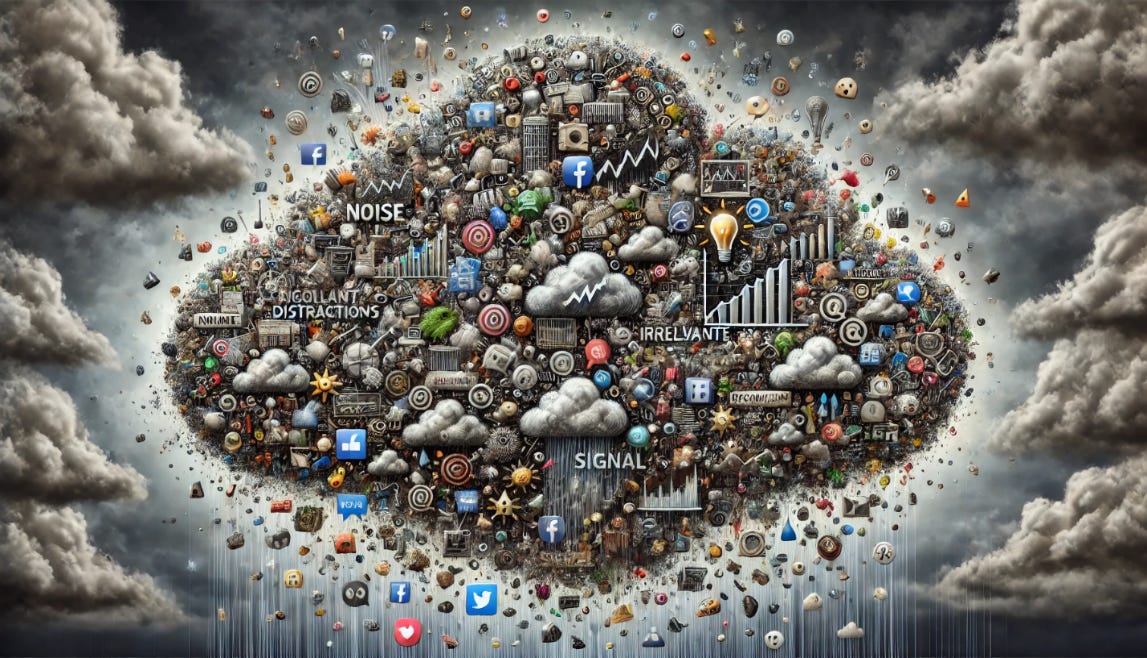Key Takeaways:
The growth of Noise has been unprecedented and accelerating.
Technology continues to evolve to generate more Noise, rather than filter it out.
AI is rapidly amplifying Noise production.
Going forward, Noise will increasingly challenge decision-makers across all fields.
In an ideal world, you could effortlessly filter out unnecessary information (Noise) and focus solely on meaningful data (Signal). You would curate your information flow to include only relevant materials that inform decision-making.
However, the sheer volume of data growth is making it impossible to passively absorb information, making it increasingly difficult to find the Signal.
Noise vs. Signal
The purpose of the 1% IRR Project is to deconstruct investing into first principles so that they can be reconstructed for better decision-making.
To deconstruct Signal vs. Noise, it’s crucial to understand the current state of Noise. Being aware of the increasing trend of Noise helps frame the search for Signal.
Part 1: The Noisy State of Noise
In 2003, Google CEO Eric Schmidt stated: “Every two days now we create as much information as we did from the dawn of civilization up until 2003. That’s something like five exabytes of data.”
He added, “The real issue is user-generated content.”
This comment predates Facebook’s founding in February 2004.
Since then, data has exploded.
DOMO, Inc., a data science company, has been publishing “Data Never Sleeps” since 2013, providing insights into the amount of data being generated and published every minute of every day.
In 2013, a subset of the stats per minute included:
YouTube users upload 48 hours of new video
Instagram users share 3,600 new photos
Brands and organizations on Facebook receive 34,722 “likes”
Over 100,000 tweets are sent
A decade later, the growth has been staggering.
This trend extends beyond user-generated content to include economic indicators. According to Nate Silver, the U.S. government provides over 45,000 economic indicators, with another 4,000,000 from the private sector.
The Future of Noise
The astonishing part of the data reviewed thus far is that it is before AI is auto-creating billions of pieces of information. There is a storm cloud of Future Noise on the horizon!
In February 2024, Sam Altman tweeted “openai [sic] now generates about 100 billion words per day …”, which the NY Times characterized as “a million novels’ worth of text every day …”
NewsGuard, a website dedicated to tracking misinformation, has identified 1,075 AI-generated news and information sites operating with little to no human oversight.
It’s important to recognize that AI is still in its infancy, with exponential growth expected.
By-Products of Noise
Financial markets will likely be affected by increasing Noise levels, potentially leading to more volatile moments.
More critically, market participants are faced with a challenge – excessive Noise impacts thinking itself. In the search for truth, the road is paved with relevant information. The prevailing viewpoint is that more data is better. While curiosity drives the search for more information, there is an argument that sifting through Noise could be counterproductive. Afterall, it steals a precious commodity – time.
1% IRR Improvements:
First Principle: Recognize the sheer volume of Noise
Anticipate the impending surge in Noise.
Develop strategies to effectively filter Signal from Noise, a topic we will explore in subsequent essays.
When Noise Becomes the Greatest Signal in the Universe
Here is the original story published in PBS. It is short and worth the read, however, for the TL;DR - below, is the ChatGPT summary 😉 …
In 1960, Bell Labs built a large antenna in Holmdel, New Jersey, for an early satellite transmission system called Echo, which bounced radio signals off balloons in the atmosphere. However, the launch of the Telstar satellite soon made the Echo system obsolete. Two radio astronomers at Bell Labs, Arno Penzias and Robert Wilson, wanted to use the Holmdel antenna for research, and when Telstar was launched, the antenna was freed up for their work.
As they began using the antenna, they encountered a persistent noise, a microwave signal coming from all directions. After ruling out various potential sources—such as interference from the city, the galaxy, and even pigeon droppings—they concluded it was not a technical issue.
At the same time, physicist Robert Dicke at Princeton was developing theories about the Big Bang, predicting that the explosion's residue would be a low-level background radiation across the universe. When Penzias and Wilson contacted Dicke’s team, they realized they had inadvertently discovered this cosmic background radiation, supporting the Big Bang theory. Penzias and Wilson’s work, published in collaboration with Dicke, earned them the Nobel Prize in Physics in 1978. Their discovery became key evidence for the Big Bang and reshaped the field of cosmology.
Take-away:
Sometimes, Noise = Signal!
Disclaimer:
The content published on The 1% IRR Project is provided for informational and educational purposes only and does not constitute financial, investment, legal, or other professional advice. The author is not a registered investment advisor, broker-dealer, or financial planner. Nothing on this site should be construed as a recommendation to buy or sell any securities or to make any financial decisions. You should consult with a qualified financial advisor or other licensed professional before making any investment or financial decisions. All views expressed are solely those of the author and are subject to change without notice.





